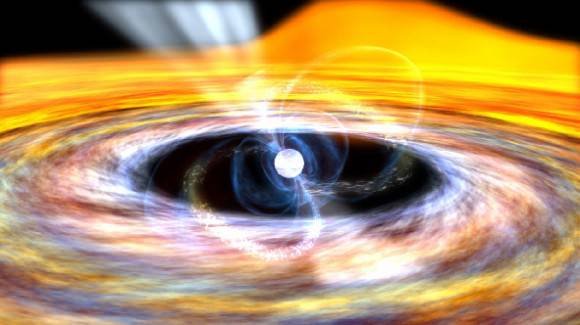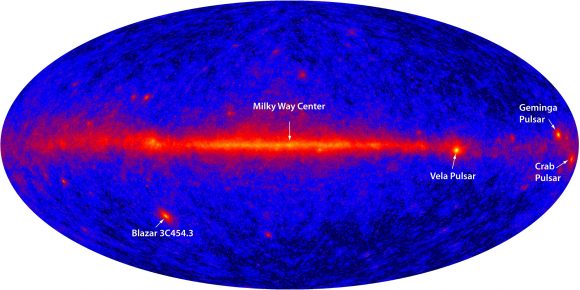Since they were first discovered in the late 1960s, pulsars have continued to fascinate astronomers. Even though thousands of these pulsing, spinning stars have been observed in the past five decades, there is much about them that continues to elude us. For instance, while some emit both radio and gamma ray pulses, others are restricted to either radio or gamma ray radiation.
However, thanks to a pair of studies from two international teams of astronomers, we may be getting closer to understanding why this is. Relying on data collected by the Chandra X-ray Observatory of two pulsars (Geminga and B0355+54), the teams was able to show how their emissions and the underlying structure of their nebulae (which resemble jellyfish) could be related.
The former of these studies - "Deep Chandra Observations of the Pulsar Wind Nebula Created by PSR B0355+54" - appeared in the November issue of The Astrophysical Journal while the latter- "Geminga's Puzzling Pulsar Wind Nebula" - has been accepted for publication. For both studies, the teams relied on x-ray data from the Chandra Observatory to examine the Geminga and B0355+54 pulsars and their associated pulsar wind nebulae (PWN).

An artist's impression of an accreting X-ray millisecond pulsar. Credit: NASA/Goddard Space Flight Center/Dana Berry
Located 800 and 3400 light years from Earth (respectively), the Geminga and B0355+54 pulsars are quite similar. In addition to having similar rotational periods (5 times per second), they are also about the same age (~500 million years). However, Geminga emits only gamma-ray pulses while B0355+54 is one of the brightest known radio pulsars, but emits no observable gamma rays.
What's more, their PWNs are structured quite differently. Based on composite images created using Chandra X-ray data and Spitzer infrared data, one resembles a jellyfish whose tendrils are relaxed while the other looks like a jellyfish that is closed and flexed. And whereas the Geminga PWN has three distinct elongated structures (two long, lateral tails and a segmented axial tail), B0355+54's PWN has a narrow double trail extending almost five light years.
In all likelihood, Geminga's and B0355+54 tails are narrow jets emanating from the pulsar's spin poles. These jets lie perpendicular to the donut-shaped disk (aka. a torus) that surrounds the pulsars equatorial regions. As Noel Klingler, a graduate student at the George Washington University and the author of the B0355+54 paper, told Universe Today via email:
"The interstellar medium (ISM) isn't a perfect vacuum, so as both of these pulsars plow through space at hundreds of kilometers per second, the trace amount of gas in the ISM exerts pressure, thus pushing back/bending the pulsar wind nebulae behind the pulsars, as is shown in the images obtained by the Chandra X-ray Observatory."
Their apparent structures appear to be due to their disposition relative to Earth. In Geminga's case, the view of the torus is edge-on while the jets point out to the sides. In B0355+54's case, the torus is seen face-on while the jets points both towards and away from Earth. From our vantage point, these jets look like they are on top of each other, which is what makes it look like it has a double tail. As Klingler put it:
"The Chandra X-ray images show that, despite their different appearances, both pulsar wind nebulae are made of the same structures: two jets of particles launched out from the pulsar poles, and an outflow of particles emanating out from the equator - both of which, in these cases, are then bent back behind the pulsars (the particle jets are initially aligned with the radio beams, but particles get bent back by the pressure, while radio beams do not). Their contrasting appearances are due to our different viewing angles (lines of sight)."
This orientation could also help explain why the two pulsars appear to emit different types of electromagnetic radiation. Basically, the magnetic poles - which are close to their spin poles - are where a pulsar's radio emissions are believed to come from. Meanwhile, gamma rays are believed to be emitted along a pulsar's spin equator, where the torus is located.
"The images reveal that we see Geminga from edge-on (i.e., looking at its equator) because we see X-rays from particles launched into the two jets (which are initially aligned with the radio beams), which are pointed into the sky, and not at Earth," said Klingler. "This explains why we only see Gamma-ray pulses from Geminga. The images also indicate that we are looking at B0355+54 from a top-down perspective (i.e., above one of the poles, looking into the jets). So as the pulsar rotates, the center of the radio beam sweeps across Earth, and we detect the pulses; but the gamma-rays are launched straight out from the pulsar's equator, so we don't see them from B0355."

An all-sky view from the Fermi Gamma-ray Space Telescope, showing the position of Geminga in the Milky Way. Credit : NASA/DOE/International LAT Team.
"So basically, by studying the X-ray images of the nebulae and its features, we were able to determine our orientations (viewing angles) with respect to the pulsars. This explains why we see only radio emission in B0355, and only gamma-ray emission in Geminga."
These observations were part of a larger campaign to study six pulsars that have been seen to emit gamma-rays. This campaign is being led by Roger Romani of Stanford University, with the collaboration of astronomers and researchers from GWU (Oleg Kargaltsev), Penn State University (George Pavlov) - and Harvard University (Patrick Slane).
Not only are these studies shedding new light on the properties of pulsar wind nebulae, they also provide observational evidence to help astronomers create better theoretical models of pulsars. In addition, studies like these - which examine the geometry of pulsar magnetospheres - could allow astronomers to better estimate the total number of exploded stars in our galaxy.
By knowing the range of angles at which pulsars are detectable, they should be able to better estimate the amount that are not visible from Earth. Yet another way in which astronomers are working to find the celestial objects that could be lurking in humanity's blind spots!
Further Reading: Chandra X-Ray Observatory
No comments:
Post a Comment